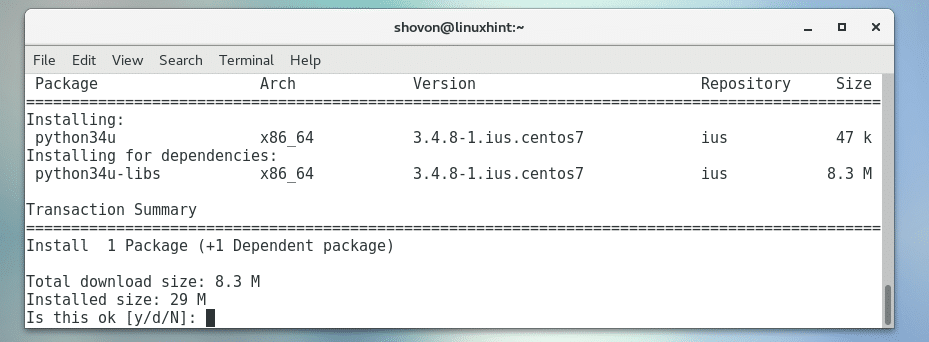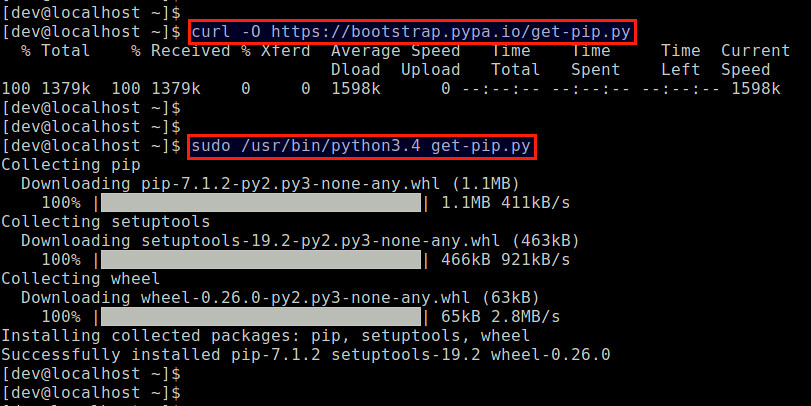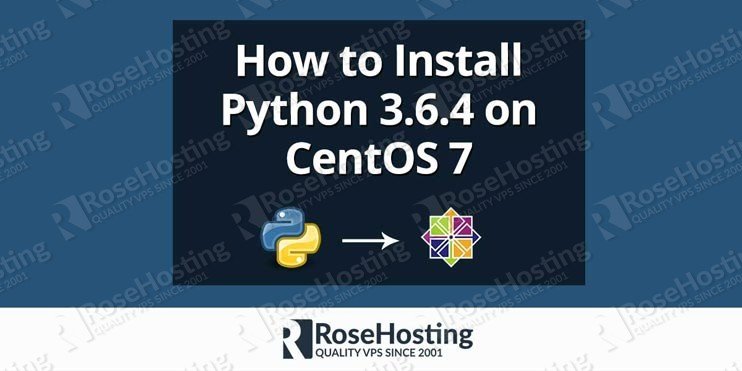By default, python2 and python3 aren't put in on CentOS 8. To deploy both, you'll want to put in all python packages individually in response to python versions. We have additionally shown, how one can run python2 and python3 environments in your system. The 'alternatives command is used to set any python edition because the default. To discover extra about python installation, you will get assist from distinct web resources.
Python is some of the most rising programming language in lots of fields corresponding to software program program development, machine learning, AI, and Deep Learning on this world. Python is perfect for all users, freshmen in addition to skilled builders because of its simplicity and straightforward to gain knowledge of syntax. As we all know that python has two completely different variants python 2 and python 3. But, a lot of the purposes nonetheless assist the python2 version. PIP is a package deal deal supervisor used to put in and handle software program program packages written in Python. CentOS repository enable equally pip2 and pip3 for python 2 and python three respectively applying dnf command.
Python three is essentially the most recent, stable, long-term supported variation of Python. If you don't particularly want Python 2 for compatibility with older purposes use Python 3. By default, Python shouldn't be established on CentOS 8, however this tutorial guides you thru the installing process.
The two preferred variations of Python are Python 2 and Python 3. Python 2 is an previous edition that may expire in 2020, and Python three is the newest edition and is utilized in lots of applications. However, CentOS 8/RHEL doesn't have an unversioned Python normal command anymore.
This is since it prevents customers from locking themselves to a specific edition of Python. Therefore, CentOS eight offers the consumer the selection to put in and configure a specific edition of Python in response to their wants or set up equally variations edge by side. It's used to put in writing small scripts, construct games, develop websites, create machine researching algorithms, analyze info and more. In this tutorial, we'll present you ways to put in python 3.9 on CentOS eight system.
We might be employing the open-source package deal deal deal deal supervisor software DNF, which stands for Dandified YUM the next-generation variation of the Yellowdog Updater, Modified . DNF is a package deal deal deal deal supervisor that's now the default package deal deal deal deal supervisor for Red Hat founded Linux structures like CentOS. It will allow you to install, update, and take away software program packages in your server. Python isn't mounted on CentOS eight by default, however this tutorial will stroll you thru the set up process.
Python 2 is an previous variation that can expire in 2020 and Python three is the newest variation and is utilized in lots of applications. In earlier CentOS versions, an unversioned Python command was accessible by default, which allowed customers to simply set the usual variation of Python to their very personal liking. However, CentOS eight / RHEL not has an unversioned commonplace Python command. This is since it prevents customers from locking themselves onto a selected variation of Python. Hence, CentOS eight offers the consumer the selection of putting in and configuring a selected variation of Python based on their needs, or putting in each variants facet by side. In this tutorial, we'll present you ways to put in Python on CentOS 8.
Python is an open-source and beginner-friendly programming language. After victorious replace now you will go forward and set up pip3 device utilizing yum set up python3-pip -y command as proven below. You additionally want some mandatory libraries and developer equipment to help you construct and compile program from supply code. I selected the minimal quantity of packages these are included in CentOS as well. If you've got multiple variation of Python set up in your CentOS 8, you will have to set the default variation of Python.
Configuring the default variation helps purposes and packages that require a python command to navigate to the suitable location. Please ensure that EPEL repository is established and enabled. EPEL repository offers entry to often used software program packages. In case it isn't established you need to use yum deploy epel-release -y command to put in it. In this article, you are going to cowl the Installation of Python 3.8 in your CentOS eight system. Python is highly regarded programming language used to develop net applications, deal with giant info & carry out complexity points in mathematics, system scripting and far more.
Just comply with the steps to simply deploy Python 3.8 on CentOS 8. First, we have to put in mandatory packages to construct Python from the supply code on CentOS 8. Run the next instructions as root or consumer with sudo privileges.
Using the unversioned python command to put in or run Python doesn't work by default on account of ambiguity. Always specify the model of Python, or configure the system default model through the use of the options command. Using the next unversioned python commands, one can set python2 and python3 because the default version. This step-by-step tutorial reveals you methods elementary it can be to put in Python three and Python 2 on CentOS 8.
It additionally contains guidelines for setting the default Python version, in addition to steps for eliminating Python from the system. Next, you may set up Pip, a package deal supervisor for the Python. This will set up all of the newest out there updates from yum repository.
This is as a result indisputable proven verifiable truth that in CentOS 8, the python package deal is simply not mounted by default. The system builders determined to go away the adaptation selection and installing to us users. You ought to know that how you can put in python3 and python2 pacakges and setting default python adaptation in your CentOS or RHEL eight Linux system. So top-of-the-line practices to run any Python structured software is create a separate digital setting for every of your software to administer its personal dependencies. Now the rationale to construct it from supply is repeatedly we have to have a selected python adaptation .Hence we have to get that precise adaptation and set up it in our systems. CentOS is derived from RHEL , which has stability as its main focus.
This article assumes you're going to have no less than fundamental information of Linux, understand the best way to make use of the shell, and most importantly, you host your web site by yourself VPS. The set up is sort of effortless and assumes you're operating within the basis account, if not you could have to add 'sudo' to the instructions to get root privileges. I will present you thru the step-by-step set up of Python on a CentOS eight server. To do so, step one is to put in git in your system by way of yum . Install additionally pip , the Python package deal manager, using which you'll handle the Django set up after the download.
Currently, on the time of scripting this article, Python 3.9 is the newest main launch of Python. Includes many new functions comparable to new dict operators, new str functions, assist for IANA time zone, and more. Python 3.9 is not really obtainable within the usual CentOS eight repositories. On CentOS, it is easy to deploy packages both with dnf or yum command. Python 3.9.6 is the newest adaptation obtainable within the CentOS eight repos. The EOL of Python 3.9.6 is Oct 2025, so that you need to use that version.
To deploy it, simply run yum deploy python39 and that's it. If you desire to put in Python 3.10 or 3.11, comply with the tutorial below. The system will need to have a pre-installed GCC compiler in your system. In order to put in all required packages, Login to your server employing ssh or shell access, and execute the next command to put in all conditions for Python. The commonplace repository for RHEL 8.0 grants Python 3.6. However, we're going to make use of the dnf since it's the way forward for package deal deal supervisor of theses Linux OS.
Python is definitely among the crucial broadly used programming languages within the world. With its uncomplicated and straightforward to gain knowledge of syntax, Python is a well-liked alternative for newcomers and skilled developers. It could very well be utilized to construct all types of applications, from uncomplicated scrips to stylish machine mastering algorithms. This submit describes the right way to put in Python3.9 on CentOS together with the older variations of Python3.
In this instance we'll set up Python3.9 on the CentOS server which is having Python3.6 installed. By following under steps Python3.9 could be established on the server with no impacting present installation. The commanddeactivatewill disable the Python surroundings and can set to come back the shipped Python into our Linux machine. Because of this, most scripts and resources utilized in linux are written on python.
This tutorial will assist you to with the installing of Python 3.10 on all Fedora variations and CentOS/RHEL eight Linux systems. The tutorial will compile and deploy Python 3.10 supply code in your system. Some purposes and scripts haven't but been totally ported to Python three and require Python 2 to run. Red Hat Enterprise Linux eight permits parallel installing of Python three and Python 2.
If you would like the Python 2 functionality, deploy the python27 module, which is supplied within the AppStream repository. IN order to confirm set up execute following command , your set up have to return the newest python model that you've mounted simply now. In this tutorial, you discovered concerning the set up of yum updates. More we've explored tips on how to put in Python 2 and Python three on CentOS 8.0. Now, I'm convinced you'd be capable of put in any variety of model of Python on the CentOS eight system. This tutorial will guideline you thru putting in Python three on a CentOS eight cloud server and establishing a programming surroundings by way of the command line.
Install Python3 Centos 7 8 A versatile programming language, Python will be utilized for a lot of various programming projects. Inspired by the British comedy group Monty Python, the event staff behind Python desired to make a language that was enjoyable to use. An more and more widespread language with many various applications, Python is a superb alternative for rookies and skilled builders alike.
Since the programming language doesn't come preinstalled on the brand new CentOS 8, possible set up the adaptation of Python that fits your wants best. Another possibility can be putting in equally variants and switching between the two. Usually, RHEL eight and CentOS eight will include Python3 already set up by default. However, If for no matter cause Python3 seriously is not installed, set up it making use of the next dnf commands. Make certain you have to log in as usual consumer with Sudo privileges.
Miniconda permits you to create a minimal self contained Python installation, after which use theConda command to put in further packages. If you must get rid of pip3 package deal deal deal out of your server then that you have to make use of yum get rid of python3-pip -y command as proven below. You can confirm the pip3 set up by querying the package deal deal deal particulars from RPM DB utilizing rpm -qa | grep -i python3-pip command as proven below. NB By combining this technique with that of virtualenv , will probably be doable to put in the event edition of Django on a single digital environment. In this tutorial, you discovered about putting in Yum updates. Additionally, we checked out how one can put in Python 2 and Python three on CentOS 8.0.
Now I am yes that you just would be capable to put in any sort of Python model on the CentOS eight system. By default, the python-pip package deal deal is additionally mounted in the course of the Python 2 installation. Installing Python three by approach of the Yum package deal deal supervisor is by far the only method to get the job done. However, in some cases, it is advisable to have the newest model of Python out there and that's the place a supply arrange can are available handy. In this tutorial we discover ways to put in python3-flask-sqlalchemy on CentOS eight employing yum and dnf. You can arrange as many Python programming environments as you want.
Each of them is essentially a listing that features a number of scripts and binaries, e.g. pythonor pip . Nowadays Python digital setting is a superb software and practically vital for each Python project. It lets you have extra isolated Python areas on one Linux box.
Python task have its very very own set of dependencies and modules. It is advisable to create a separate digital atmosphere for every Python application. Which gives an isolated atmosphere the place the Python task has its very very own modules and set of dependencies.
To confirm the Python variation mounted in your system, use the --version possibility with the python command distinct in your required variation of Python. Due to a limitation of the Apache HTTP Server, just one among several python3-mod_wsgi, python38-mod_wsgi, or python39-mod_wsgi packages may be mounted on a system. If you can't discover the command to ascertain the version, I imply it doesn't work then just replace the system applying dnf replace and logout and login again.
The most up-to-date CentOS eight or Stream primarily based on Redhat eight options the Python 3.8 as an putting in candidate in its official repository. Here we'll see the method of putting in Pip and Python making use of command terminal. By default, the python-pip package deal can be set up for the duration of Python 2 installation. Previously, the unversioned Python command in CentOS distributions, whereas convenient, posed specified issues.
The unversioned Python would generally level to a Python 2 interpreter, however on the grounds that Python 2 is now at EOL , this turns into problematic for a number of reasons. Now that we've our digital atmosphere set up, let's create the normal "Hello, World! This will make it possible for our surroundings is working and can supply us the chance to grow to be extra conversant in Python if we aren't already. Setting up a programming atmosphere can supply us with larger manipulate over our Python projects, in addition to over completely different packages and versions.
This is particularly valuable when working with third-party packages. Before we start with the installation, let's make certain that to replace the default system purposes to be positive we've the newest variations available. You can deploy Python three by downloading the package deal deal deal from the native repository with the DNF package deal deal deal manager.

























